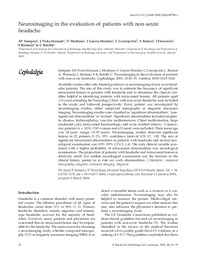Please use this identifier to cite or link to this item:
https://hdl.handle.net/11000/30552Full metadata record
| DC Field | Value | Language |
|---|---|---|
| dc.contributor.author | Perez-Sempere, Angel | - |
| dc.contributor.author | PORTA-ETESSAM, JESÚS | - |
| dc.contributor.author | Medrano, V | - |
| dc.contributor.author | Garcia-Morales, I | - |
| dc.contributor.author | Concepción, L | - |
| dc.contributor.author | Ramos, A | - |
| dc.contributor.author | Florencio, I | - |
| dc.contributor.other | Departamentos de la UMH::Medicina Clínica | es_ES |
| dc.date.accessioned | 2024-01-22T17:42:44Z | - |
| dc.date.available | 2024-01-22T17:42:44Z | - |
| dc.date.created | 2005-01 | - |
| dc.identifier.citation | Cephalalgia published January 2005 | es_ES |
| dc.identifier.issn | 1468-2982 | - |
| dc.identifier.issn | 0333-1024 | - |
| dc.identifier.uri | https://hdl.handle.net/11000/30552 | - |
| dc.description.abstract | Available studies offer only limited guidance on neuroimaging of non-acute headache patients. The aim of this study was to estimate the frequency of significant intracranial lesions in patients with headache and to determine the clinical variables helpful in identifying patients with intracranial lesions. All patients aged ≥l 15 years attending the Neurology Clinic with non-acute headache were included in the study and followed prospectively. Every patient was investigated by neuroimaging studies, either computed tomography or magnetic resonance imaging. Neuroimaging results were classified as ‘significant abnormalities’, ‘nonsignificant abnormalities’ or ‘normal’. Significant abnormalities included neoplastic disease, hydrocephalus, vascular malformations, Chiari malformation, large arachnoid cysts, intracranial haemorrhage, and acute cerebral infarcts. Consecutive patients (n = 1876; 1243 women and 633 men) were included. Their mean age was 38 years (range 15-95 years). Neuroimaging studies detected significant lesions in 22 patients [1.2%, 95% confidence interval (CI) 0.7, 1.8]. The rate of significant intracranial abnormalities in patients with headache and normal neurological examination was 0.9% (95% CI 0.5, 1.4). The only clinical variable associated with a higher probability of intracranial abnormalities was neurological examination. The proportion of patients with headache and intracranial lesions is relatively small, but neither neurological examination nor the features in the clinical history permit us to rule out such abnormalities | es_ES |
| dc.format | application/pdf | es_ES |
| dc.format.extent | 6 | es_ES |
| dc.language.iso | eng | es_ES |
| dc.publisher | SAGE Publications | es_ES |
| dc.rights | info:eu-repo/semantics/openAccess | es_ES |
| dc.rights | Attribution-NonCommercial-NoDerivatives 4.0 Internacional | * |
| dc.rights.uri | http://creativecommons.org/licenses/by-nc-nd/4.0/ | * |
| dc.subject | headache patients | es_ES |
| dc.subject | neuroimaging studies | es_ES |
| dc.subject | vascular malformations | es_ES |
| dc.subject.other | CDU::6 - Ciencias aplicadas::61 - Medicina | es_ES |
| dc.title | Neuroimaging in the evaluation of patients with non-acute headache | es_ES |
| dc.type | info:eu-repo/semantics/article | es_ES |
| dc.relation.publisherversion | https://doi.org/10.1111/j.1468-2982.2004.007 | es_ES |

View/Open:
2-Cephalalgia (1) (1).pdf
66,93 kB
Adobe PDF
Share:
.png)
